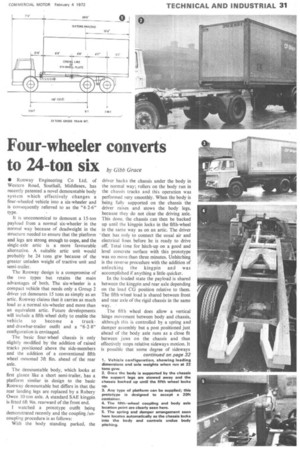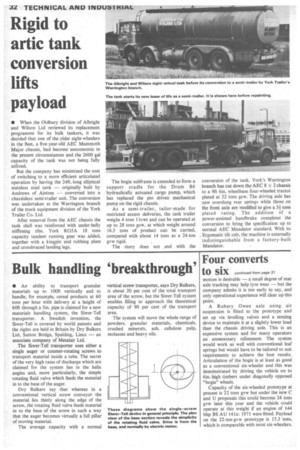Four-wheeler converts to 24-ton six
Page 33

Page 34

If you've noticed an error in this article please click here to report it so we can fix it.
by Gibb Grace • Ronway Engineering Co Ltd; of Western Road, Southall, Middlesex, has recently patented a novel demountable body system which effectively changes a four-wheeled vehicle into a six-wheeler and is consequently referred to as the "4-2-6" type.
It is uneconomical to demount a I5-ton payload from a normal six-wheeler in the normal way because of deadweight in the structure needed to ensure that the platform and legs are strong enough to cope, and the single-axle artic is a more favourable alternative. A suitable at-tic unit would probably be 24 tons gtw because of the greater unladen weight of tractive unit and semi-trailer.
The Ronway design is a compromise of the two types but retains the main advantages of both. The six-wheeler is a compact vehicle that needs only a Group 2 driver yet demounts 15 tons as simply as an artic. Ronway claims that it carries as much load as a normal six-wheeler and more than an equivalent artic. Future developments will include a fifth-wheel dolly to enable the vehicle to become a truckand-drawbar-trailer outfit and a "6-2-8-" configuration is envisaged.
The basic four-wheel chassis is only slightly modified by the addition of raised tracks positioned above the side-members and the addition of a conventional fifth wheel mounted 3ft 8in. ahead of the rear axle.
The demountable body, which looks at first glance like a short semi-trailer, has a platform similar in design to the basic Ronway demountable but differs in that the rear landing legs are replaced by a Rubery Owen 10-ton axle. A standard SAE kingpin is fitted 6ft 9in. rearward of the front end.
I watched a prototype outfit being demonstrated recently and the coupling /uncoupling procedure is as fdllows: With the body standing parked, the
driver backs the chassis under the body in the normal way; rollers on the body run in the chassis tracks and this operation was performed very smoothly. When the body is being fully supported on the chassis the driver raises and stows the body legs, because they do not clear the driving axle. This done, the chassis can then be backed up until the kingpin locks in the fifth-wheel in the same way as on an artic. The driver -then has only to connect the usual air and electrical lines before he is ready to drive off. Total time for hitch-up on a good and level concrete surface with this prototype was no more than three minutes. Unhitching is the reverse procedure with the addition of unlocking the kingpin and was accomplished if anything a tittle quicker.
In the loaded state the payload is shared between the kingpin and rear axle depending on the load CG position relative to them. The fifth-wheel load is shared between front and rear axle of the rigid chassis in the same way. • The fifth wheel does allow a vertical hinge movement between body and chassis, although this is controlled by a spring and damper assembly but a post positioned just ahead of the body axle runs as a close fit between jaws on the chassis and thus effectively stops relative sideways motion. It is possible that some degree of sideways motion is desirable — a small degree of rear axle tracking may help tyre wear — but the company admits it is too early to say, and only operational experience will clear up this point.
A Rubery Owen axle using air suspension is fitted to the prototype and set up via levelling valves and a sensing device to maintain it at a slightly lower load than the chassis driving axle. This is an expensive system and for many operators an unnecessary refinement. The system would work as well with conventional leaf springs but would have to be tailored to suit requirements to achieve the best results. Articulation of the bogie is at least as good as a conventional six-wheeler and this was demonstrated by driving the vehicle on to 6in.-high timbers under diagonally opposed "bogie" wheels.
Capacity of the six-wheeled prototype at present is 22 tons gvw but under the new C and U proposals this could become 24 tons gvw later this year and the vehicle could operate at this weight if an engine of 144 bhp BS AU 141a: 1971 were fitted. Payload on the 22-ton-gvw prototype is 15.3 tons, which is comparable with most six-wheelers.














































































































































